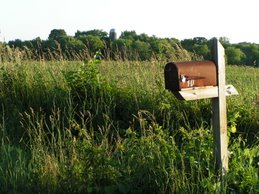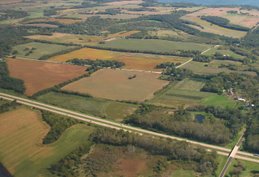Comments submitted to Ruekert Mielke
By Rosanne Lindsay, Fitchburg
The city of Fitchburg recently received a Draft Conceptual Storm Water Study which, if approved, would attempt to mitigate runoff pollution from a proposed development in the Northeast Neighborhood. I reviewed this draft Stormwater study using current statutes and recent published studies to determine whether it could be implemented to protect the natural resources and the public health.
Additional Studies Recommended
The authors of this plan state,“The Northeast Neighborhood planning area and surrounding properties have significant natural resource features that require protection.” They further recommend additional studies prior to development which “would include a more detailed evaluation of how the proposed development would affect the groundwater system, including storm water recharge, water quality and spring flow protection.”
To the authors’ credit, the plan area is indeed situated near a natural treasure in Dane County. The area is home to woodlands, wetlands, hydric soils (historic wetlands), Big Fen, Murphy and Swan Creeks, Deep Spring, and Lake Waubesa. Thus, I encourage the city to await results from several ongoing studies that will evaluate many of the stated concerns.
Spring flow protection is relevant because Deep Spring helps freshen the lower two-thirds of Lake Waubesa, and depends on adequate groundwater flow and recharge. Wisconsin has taken steps to protect springs under (2003 WI Act 310, p.2); and the Wisconsin Department of Natural Resources is now charged with evaluating whether groundwater pumping by new high-capacity wells will impact these springs.
A groundwater study should also be conducted. In Dane County, large water withdrawals from the aquifer and the diversion of about 50 million gallons per day to Badfish Creek results in a net deficit to our aquifer. Waukesha, New Berlin, and Green Bay are examples of cities that have depleted their clean groundwater and will spend tens of millions of dollars to clean the contaminated water that’s left or find a new source.
Water levels in the region have dropped enough that the computer model used to calculate the impacts of new wells on the aquifer and surface water in Dane County will need to be updated before future decisions on groundwater use are made, according the model’s author, hydrologist Ken Bradbury.
Additional research, including a graphic model of key hydrologic interactions of the study area, is also being conducted by UW scientist and world renowned wetlands expert, Professor Cal DeWitt.
No Implementation Plan
According to the authors, the purpose of this stormwater plan is “to provide directions and standards” to reduce runoff pollution resulting from development, avoid the creation of future problems, and protect natural resources, using seven goals. However, the plan also states that “no recommendations on how or where storm water management measures will be implemented are included as part of this report.”
A plan based on “goals” without specifying enforceable measures to meet those goals cannot ensure that pubic health and natural resources in the area will be protected.
For example, the goal to “preserve and reproduce existing hydrologic conditions,” by itself, represents a major challenge to the city. In simple terms, the “hydrology” of a watershed is dependent on two main criteria: adequate surface flow which feeds both spring flow and the lake, and adequate infiltration for groundwater recharge. Changing either criteria, even by small amounts, can alter existing hydrology. So the real question becomes can infiltration and groundwater recharge be preserved?
Inadequate Measures for Groundwater Recharge
The 2005 Dane County Water Body Classification Study showed that even low levels of development upland from a watershed will impact and often degrade the hydrology and predictability of the water system. In fact, the County recently revised its stormwater ordinance (Ch 14) to replace caps on maximum land area required for infiltration. New language aims to maintain pre-development groundwater recharge through new design practices and flexibility to the developer.
However, groundwater recharge rates are highly difficult to measure directly or to estimate accurately, and vary with geologic conditions, land use, soil class, and changes in precipitation. Without a specific site evaluation, it would be hard to determine what standards are needed to protect or improve upon the water quality, groundwater supply, or flood protection for this area. Neither the State Code (NR 151) nor County standards are “resource based” (watershed specific).
Moreover, would existing models allow developers the flexibility to develop new approaches to improve infiltration at the site when specific site data is lacking? This question further demonstrates the need to wait for site-specific research.
Finally, this study makes no requirements for testing, monitoring, inventorying, or reporting infiltration amounts. There are no funding resources at the County to capture and maintain these inventories and there are limited resources at the city level. How will the city verify that any implementation of stormwater controls meets the original goal?
Pollution Standards Lacking
According to a 2002 EPA Water report, pollution from runoff during and after rainfalls is now the single largest cause of water pollution. A 2006 EPA Report shows 40% of streams to be in poor condition due to increased sediments. This suggests current protections under the State and County Stormwater Management Standards do not necessarily guarantee the protection of public health and safety or the natural resources in the plan area.
Conceptual Study Insufficient
This study is only a concept. Each goal that might be implemented omits an objective assessment of efficacy. It is impossible to evaluate what the outcome might be with respect to probable percent reduction in stormwater runoff and erosion, even if all of the suggested measures were employed in response to development in the Northeast Neighborhood Plan area. Therefore, the city should not use this study as a means to approve any neighborhood development plan, any growth boundary, or any extension of urban services.
Recently, a newly formed regional planning body was created by Governor Doyle. The Capital Area Regional Planning Commission (CARPC), charged with planning growth and protecting the county's water resources, should be able to further study this issue and the aforementioned ongoing studies to determine whether this plan, and others submitted, merits extension of Urban Services to develop the environmentally sensitive Northeast corner of Fitchburg.
A version of these comments was published in the June 28, 2007 issue of the Fitchburg Star.
Additional comments:
1) The level of protection specified under Stormwater Management Standards (Appendix A), does not guarantee the protection of public health and safety. One need only look to the best management practices (BMPs) used in Waukesha (the home site of Ruekert Mielke), to see that the public health protection is not guaranteed. Radium levels in drinking-water, there, remain over federal drinking water standards.
2) Where are the study elements for protecting Wetlands? This study merely pays lip service to the wetlands located to the south (Waubesa) and north (Nine Springs) but does nothing to ensure their protection. Any real stormwater plan must include the protection of the wetlands as part of the special, natural, integral features of this area. (See p. 41of Dane County Water Body Classification Study):
“- Since wetlands are degraded by the same processes that affect streams and lakes and greatly contribute to their overall health and well-being, they too should be afforded the same level of protection and emphasis.
- Even wetlands smaller than 2 acres play important roles, individually and cumulatively. Protection should be based on field delineation, working around these areas or incorporating them into the design.
- Prior-converted wetlands and others that have been ditched or drained should be restored and enhanced.”
3) Further studies related to development in the NEN should be conducted including:
- A groundwater (hydro-geologic) study of the aquifer in the NEN showing the effects of development from increased well pumping.
- Cost of Community Services Study related to costs of development (i.e, water, sewer, and new roads and interchanges), that are passed on to the community. Virtually all of these cost studies show that residential land is a net drain on local government budgets and that it brings costs to the community that are not fully borne by the new residents but are instead distributed throughout the community. Findings show that for every dollar collected in taxes and non-tax revenue, between $1.15 and $1.50 must be spent in the form of local government services. (see study from the Town of Holland in La Crosse, WI: http://www.co.la-crosse.wi.us/TownOfHolland/Docs/COCSreport.pdf
and this study from the towns of Dunn, Perry and Westport http://www.pats.wisc.edu/abscost.htm).
In fact, proponents of farmland and open space preservation now have an important economic argument on their side.
- Transportation Study showing the impacts of traffic flow and increases in traffic and pollution to the area.
Thank you for the opportunity to submit my comments.



No comments:
Post a Comment